This is Part 1 of “They shoot children, don’t they?”, a report by Professor Liam Kennedy of Queen’s University Belfast on paramilitary attacks on children in Northern Ireland from 1990 to 2013. It is launched today to mark this month’s 25th anniversary of the UN Convention on the Rights of the Child.
- This is Part 1 of the report – Overview and Statistics
- This is a link to Part 2 – Case Studies and Conclusion
The report documents an aspect of both green and orange paramilitarism that should not be forgotten – the ruthless beatings and shootings of civilians, including teenagers and children, who were members of the very communities that the paramilitaries claimed to be defending.
Professor Liam Kennedy was born in Tipperary and educated at Cistercian College Roscrea, University College Cork and the University of York. He has lived in Belfast since 1976. He has written, edited or co-edited a dozen books on modern Irish history and is emeritus professor of economic history at Queen’s University, Belfast. He is a member of the Royal Irish Academy.
I am proud to have worked with Liam over the years on various peace and justice initiatives in Northern Ireland. He has always displayed courage, a passion for justice, and an independent analytical research approach that is reflected in this important report.
Contents of Part 1 – Overview and Statistics
1. Overview details
2. Other key points
3. “He only turned 14 in July”
4. Iron discipline
5. Age and “punishment” attacks
6. Tables on age and “punishment” attacks
7. Parity of Esteem: Loyalist and Republican Paramilitaries
8. Expulsions or exiling
9. Green-on-green and orange-on-orange violence
10. Punish the child
11. Tables 3 & 4 – Children subjected to “rough justice”
12. Change over time
13. Figures 1 & 2 – “punishment” attacks on children
14. Gender and “punishment” attacks
15. Table 5 – paramilitary-style assaults on women
Contents of Part 2 – Case Studies and Conclusion
16. Women under threat
17. “…To send her son out to get shot”
18. The United Nations Convention on the Rights of the Child
19. Ardoyne, Belfast – a blackspot for abuse
20. Exiles
21. A Nelsonian blind eye
22. The media and child abuse
23. Breaking the silence – three case studies
24. The case of Michael McConville
25. The case of Paul Quinn
26. The case of Robert McCartney
27. Conclusion
Part 1 – Overview and Statistics
1. Overview details
- Between 1970 and 2005, and to a lesser extent in recent years, loyalist and republican paramilitaries ruled the communities they controlled with an iron rod, sometimes literally so.
- A significant proportion of the victims of vigilante ‘policing’ were children. The ‘punishments’ inflicted on young bodies included shootings and severe beatings using a variety of improvised weapons including iron bars, cudgels, hammers, and hurley sticks.
- We only have detailed age statistics for the period 1990-2013 and, like rape statistics, these are widely acknowledged to be underestimates.
- In addition, large but unknown numbers of children were subjected to torture, mutilation and psychological terror during the first two decades of the ‘Troubles’, that is, during the 1970s and the 1980s. We do not have statistics, broken down by age, for those years, though the total number of cases for those years is known.
Between 1990 and 2013:
- 94 children were shot by loyalist paramilitaries.
- 73 children were shot by republican paramilitaries.
- 166 children were beaten – some badly mutilated – by loyalist paramilitaries.
- 178 children were beaten by Republican paramilitaries.
- In total, more than 500 children abused by the IRA, UVF, UDA etc.
2. Other key points
- During the Troubles thousands of individuals and sometimes whole families were driven from their homes by loyalist and republican paramilitaries. Many of these exiles sought safety in Britain but some republican victims fled to the Republic of Ireland. Some still live south of the Border. Returning home is not an option.
- Strange as it may seem, ‘exiling’ is considered second only to execution in the ‘punishment’ stakes by some, particularly those children who have dropped out of the educational system, have poor employment prospects and few life skills.
- The “punishment” system generated its own automatic cover-up. Every victim understood that speaking to the media or the authorities more generally could result in further attacks on them or their loved ones. Virtually without exception, every victim of a paramilitary “punishment” I have spoken to is unwilling to discuss his or her ordeal in public. ‘You never know.’
- Those who spoke openly and critically, and these were only a handful of victims, could be punished/attacked again. (I know of one young man who was ‘battered’ a second time after he appeared in a TV documentary.)
- Some children committed suicide following a beating or the beating of a friend (see the section in the Report on Ardoyne).
- It is not sufficiently appreciated that attacks on children actually intensified in the years after the paramilitary ceasefires of 1994 and continued at high levels for a number of years after the signing of the Good Friday Agreement. Thus, we are not talking about a phenomenon confined to the early years of the Troubles. This means the victims and the perpetrators are very much in our midst.
- It is widely believed in Belfast and in other parts of the North that Sinn Féin collaborated with the IRA in attacks on children. There was of course overlapping membership. The Sinn Fein centre, Connolly House in Andersonstown, was mentioned over and over again as a coordinating centre for ‘punishment’ attacks on children and adults in West Belfast.
- Leading members of Sinn Féin, including Mr Adams, while distancing themselves in public from the ‘punishment’ system, were content to describe practices that amounted to the torture of children as ‘rough justice’. Victims might well question the terms ‘rough’ and ‘justice’.
- Males generally ran the ‘punishment’ practices in loyalist- and republican-controlled areas but I have been told by a former public representative that at least one female Sinn Féin activist delivered notices to families telling them where to take their sons to be ‘shot by appointment’.
- A few years ago I spoke to a Sinn Féin activist in Belfast who told me almost casually that he had done lots of ‘punishment’ shootings in his time. (‘What else could we do?’, was his view.)
- Sinn Féin has urged victims of child sexual abuse to speak to the police. This is of course an appropriate thing to do, and is necessary to bring perpetrators of child abuse to justice. However, coming from Sinn Féin, it does nothing to lift the weight of fear at street level in working-class areas. This is because members of Sinn Féin have been part of the “punishment” system for years, Sinn Féin and IRA membership heavily overlapped, and Sinn Féin advice centres were used to collect information and interrogate potential victims. In view of the Sinn Féin track record on child abuse it is hardly surprising that victims are sceptical of any assurances coming from the party, or, on the loyalist side from the UDA or the UVF.
- These various practices amount to gross human rights violations under the criteria employed by the UN Convention on the Rights of the Child. The UN Convention document provides the framework for this Report.
3. “He only turned 14 in July”
“They never said what he had done wrong. They just dragged Eamon from the bed, threw him all the way down the stairs, lay him on his back and beat him with sticks embedded with huge nails while my parents pleaded with them to leave him alone because of his age. He only turned 14 in July.” [1]
This is the voice of Eamon’s sister who dared to speak about the ordeal of her younger brother. Five masked men from the North Armagh Brigade of the Provisional IRA smashed their way into the O’Hanlon home, late at night, threatening the parents at gun point. The mother and father were obliged to stand by and listen helplessly to the screams of their son. After the ordeal the child was taken to the Royal Victoria Hospital for Sick Children, some 30 miles away in Belfast. His parents did not speak openly or publicly. To do so, would have invited further retaliation, possibly against the whole family. This was one year after the signing of the Good Friday Agreement.
Dr Lawrence Rocke, senior consultant surgeon in the accident and emergency department of the Royal Victoria Hospital in Belfast says that the youngest victim of a “punishment” beating he treated was just 14 years old. But many others were only a year or two older. In his view, “it beggars belief how people can set out to cause pain and hurt of the terrible type we see in here so often.” [2]
One of the great revelations in the history of Irish society in the late twentieth century was the extent of institutional child abuse, often carried out by Irish Catholic priests, brothers and nuns. This was on a scale that was both shocking and hitherto unrealised. [3] At the same time as these abuses were being uncovered, the systematic abuse of children by paramilitary organisations was widespread. As in the case of Catholic religious organisations in the past, the stricture to remain silent ensured relatively little publicity. But unlike the case of the Catholic church, which sometimes used legal agreements, paramilitary organisations had the threat of men armed with guns, cudgels and iron bars, to enforce silence.
4. Iron discipline
“One of them pulled an iron bar from inside a jacket and hit him across the face.” This was the opening blow of a “punishment” attack on a 15 year-old child. The beating, which involved five masked men believed to be members of the Provisional IRA, took place in a home in the strongly nationalist New Lodge area of north Belfast on Sunday, 11 March 2001. The boy, who had special needs and admitted to juvenile delinquency, was taken to the bedroom where he was struck with iron bars for twenty minutes. The blows were mainly to his head and upper body. His jaw was fractured during the attack. Traumatised, disfigured and barely able to speak, he was taken to hospital. Because his mother, a single parent, voiced her outrage and despair, the name of the boy, George McWilliams, featured momentarily in the columns of the nationalist Irish News. [4]
In January of the same year up to ten masked men, carrying guns and batons, burst into a home on a housing estate in Belfast. Their target was a 16-year old boy with a reported IQ of 45. Gerard had a troubled history, including severe depression since he had been raped as a child by a relative. When his mother tried to protect him from the intruders, she was also struck and called a “fucking bitch”. The local administrators of justice then forced Gerard upstairs to the bathroom and, in the words of his mother: “I could hear him screaming from in there. After that they dragged him outside to the alleyway. I went into the bathroom and saw blood everywhere; after that I passed out”. [5]
5. Age and “punishment” attacks
Before looking at children in some detail, it is helpful to view the age profile of victims of paramilitary shootings and assaults more generally. Andrew Silke in a powerful article, “Lords of Discipline”, quotes a youth worker to the effect that “the rule is that the Provos don’t punish – that is, don’t shoot or severely beat – kids under sixteen.” [6] But was this true? Detailed statistics on the age breakdown of victims are only available from 1990 onwards, which misses out most of the period of the Troubles. Still, this gives a time span of almost a quarter century, and covers the last years of violent conflict, as well as the early peace process and its aftermath. The information is from the files of the Central Statistics Unit of the RUC and later the PSNI Statistics Branch. [7] As always, it needs to be borne in mind that these were the reported cases only and are widely acknowledged to be underestimates of the true incidence of abuse.
Tables 1 and 2 present the number of victims falling into the different age groups. The age profiles of the casualties from shootings and beatings appear broadly similar. Men in their twenties – the great majority of victims were male – account for almost half of the casualties, be it “punishment” shootings or beatings. [8] The proportions taper away on either side of this modal age group. A simple majority of the victims were in the age range 18 to 29 years. A small minority were much older, aged 50 years or above, and these were more likely to be subjected to beatings rather than shootings. The age range across the “punishment” spectrum was wide. The oldest man shot by loyalists was aged 58 years, while the oldest shot by republicans was a 68 year-old pensioner. The oldest age for an assault victim was 75 years. He was “punished” by loyalist paramilitaries in the year 2000. Republicans had given a paramilitary-style beating to their oldest victim, a 73 year-old man, a few years earlier in 1997.
6. Tables 1 & 2 on age and “punishment” attacks
Summarising the information in Table 1, the number of shootings of loyalists (all age groups) by loyalists was 1,077 and the number of beatings was larger still at 1,413 for the period 1990-2013. On the republican side (Table 2), the comparable number of shootings was 759 and of beatings 1,022. The overall picture, if we add together shootings and beatings, is that in the period 1990-2013, which roughly approximates the last quarter century, there were more than 4,000 pre-mediated paramilitary-style attacks on civilians.
7. Parity of Esteem: Loyalist and Republican Paramilitaries
Viewing the longer time span of the last four decades or so, there was little to choose between loyalist and republican paramilitaries in terms of responsibility for “punishment” attacks. Each accounted for one half of the victims of paramilitary-style beatings. For paramilitary-style shootings the story was broadly the same, with republicans being responsible for a slightly larger share. It is also the case that republicans tended to concentrate their attentions on children to a greater degree than loyalists.
In the early years, republicans dominated the vigilante stakes; in later years loyalists came increasingly to the fore, in part perhaps emulating republicans, though situational factors were likely to have dominated, including intra-paramilitary feuding. In the final years of the period, since the signing of the Good Friday Agreement in 1998, loyalists accounted for a majority of “punishment” beatings and shootings.
8. Expulsions or exiling
This was a sanction that some victims found particularly hard to bear and for some it was second only to death in the scale of “punishments”. Separated from family and friends, isolated in a foreign city, some descended into depression and further trouble. Some were “inadequate people who might have medical and social problems”, according to the human rights campaigner, Fr Denis Faul. The practice was that targets of paramilitary, and sometimes community displeasure, were ordered to leave home and not return to the area, under pain of possible execution. The areas of geographical exclusion might vary. Some were expelled from their neighbourhood to another part of Northern Ireland, either near or far. Sometimes a time period was specified. As often as not, the exclusion was open ended. Should the victim reappear in his home area without paramilitary permission, then all bets were off in terms of the possible “punishment”. Some were told they had to leave Northern Ireland, with many of these finding their way to Britain. The impressionistic evidence is that while a majority were displaced to England or Scotland some sought refuge in the Republic of Ireland. [9]
Thousands were exiled during the course of the Troubles. [10] The reason that banishment bore heavily on some exiles is that they often came from unemployed backgrounds, suffered from educational disadvantage, had few social connections elsewhere, and had few of the personal skills needed to navigate a strange and often threatening environment. Moreover, if the exiled person was a child or teenager, as was frequently the case, the whole family might feel obliged to move. This meant living in emergency accommodation, often hostels. Provision for children was minimal and some parents worried that they were sharing with criminals and alleged paedophiles. On top of that there was the disruption to children’s schooling, to social networks, to employment opportunities, and to mental health. Miserable living conditions were likely to exacerbate tensions within the family, with the victim sometimes blamed for the burdens brought on the family. According to care workers, dependence on tranquilisers or even illegal drugs could become part of the downward spiral in which individuals and families were trapped. [11]
9. Green-on-green and orange-on-orange violence
It is important to emphasise that these were intra-community intimidatory practices. This is important because some outside observers find it well nigh impossible to believe that so much republican and loyalist violence was directed against members of their “own” community. So, to be absolutely clear, these were not acts of violence directed against the communal “other”; these were green-on-green and orange-on-orange attacks. Sectarian, communal and ethno-national conflicts were another matter, though inevitably they were all inter-connected strands in a larger web of political violence.
A few further points are worth stressing. Those who offer rationalisations for human rights abuses against children typically argue that paramilitaries found their “policing” role a nuisance or a distraction from their primary raison d’etre. This claim does not square with the evidence. Vigilante justice and child abuse actually intensified from the mid-1990s, after loyalist and republican paramilitaries went on ceasefire.
There is also the recent suggestion by Mr Gerry Adams, president of Sinn Féin, that IRA “rough justice” was particularly brutal during the first two decades of the Troubles. The implication seems to be that paramilitary actions were less brutal thereafter. [12] This is questionable. But the attacks on Robert McCartney, Paul Quinn and many others (see case studies later in this Report), suggest no diminution in the cruelty with which attacks were carried out. Moreover, the notion of “rough justice”, which Mr Adams and others use, has all the hallmarks of a euphemism designed to deflect attention from the gravity of the human rights abuses committed by loyalist and republican paramilitaries.
10. Punish the child
The United Nations Convention on the Rights of the Child came into force on the 2nd of September 1990. Article 1 defined a child as “every human below the age of 18 years” (unless there was specific national legislation that conferred adulthood earlier). [13] This is the definition of a child adopted here, though a more detailed age classification is also used. Just how young were some of the victims? We can, in fact, get a fairly refined picture of the age of victims from figures collected by the Central Statistics Unit of the RUC and later the PSNI Statistics Branch. This information is presented in Tables 3 and 4. It will come as a shock to many, even to well-informed commentators on Northern Ireland, that since 1990 loyalist paramilitaries shot and intentionally wounded 94 children aged 17 years or younger from within the unionist population. Republicans were not far behind: their haul of child-victims from the nationalist community amounted to 73.
Vigilante-style beatings of children, or “batterings” as one IRA man graphically put it, were on a considerably larger scale. [14] Loyalists were responsible for 166 such attacks on children, while republicans “battered” 178 children between the years 1990 and 2013. Even very young children – fifteen-year olds – could be subjected to a shooting. In terms of beatings by vigilantes, the youngest victims were very young indeed. Loyalist paramilitaries attacked a nine-year old child in 2009 while republicans gave paramilitary-style beatings to three twelve-year olds in 2001. During the period 1990-2013 most shootings of children were carried out by loyalists (94 cases) while most beatings of children were carried out by republicans (178 cases). Making allowance for differences in population share, nationalist children were more likely to be the victims of paramilitary violence, and particularly so of paramilitary-style beatings. This seems equally likely for the two decades of the Troubles prior to 1990, in view of the attitude to “policing” adopted by the Provisional IRA. Nonetheless, little should be made of these differences. All too often in debates on the Troubles small differences are highlighted so as to deflect attention from the main concern. Of far greater significance is the ugly common denominator: both sets of paramilitaries terrorised large numbers of children and young people over long periods of time. The truly shocking summary point is that since 1990 in excess of 500 children were forced to undergo vigilante-style shootings or beatings. These are the officially recorded instances only.
11. Tables 3 & 4 – Children subjected to “rough justice”
12. Change over time
Peace came dropping slowly for the children of Northern Ireland, as Figures 1 & 2 demonstrate. So, looking at change over time, both loyalist and republican paramilitaries increased the level of repression against children in the decade after the paramilitary ceasefires of 1994. The point is underlined further if we take into account the large numbers of young people exiled in these years, for whom no precise figures exist. Vigilante-style beatings roughly doubled as compared to the years immediately preceding the ceasefires. In a belated improvement they then tapered off steeply after 2004, in part it would seem due to political pressure and persuasion. This was particularly true of the Provisional IRA, the organisation which historically had been responsible for most shootings and mutilations, and which withdrew into the shadows in these later years. Between 2004 and 2013 most beatings were due to loyalist paramilitaries, while in those years responsibility for shootings was roughly equally shared between loyalist and republican groups. This was also a period of murderous attacks on alleged drug dealers by republican paramilitaries, particularly but not exclusively in Derry. [15] In 2013, the final year of this study, one child aged either 14 or 15, was shot by loyalists and two children were subjected to paramilitary-style beatings. There were no child victims of republican-aligned groups in 2013. Whether this was the end game or not only time will tell.
13. Figures 1 & 2 – “punishment” attacks on children
14. Gender and “punishment” attacks
It is overwhelmingly the case that males from working-class backgrounds were the targets of the paramilitary “punishment” system. This was because young males were more likely than young women to be involved in anti-social behaviour, as perceived both by paramilitaries and members of local communities. But gender mattered in its own right and the line was not easily crossed. One IRA operative for instance claimed that the IRA was “operating within a sophisticated set of informal restrictions on their behaviour, no less powerful for being largely unspoken.” [16] There were limits no doubt but a claim of this kind is too timeless to capture the changing nature of paramilitary control and retaliation. The informal codes themselves evolved over time under pressure of circumstances. Gender alone was not a safeguard against attack. This was particularly evident on the loyalist side, where loyalist paramilitary assaults on women (of all ages) were much more frequent than in republican-controlled areas. [17]
Most of the women attacked by loyalists and republicans were in their twenties or in their thirties, but young girls were not exempted either. Republicans were almost twice as likely to “punish” children – girls aged seventeen years or less – as compared to loyalists, which is again suggestive of the “policing” role assumed by republicans.
15. Table 5 – paramilitary-style assaults on women
Further research is needed to tease out the motivations, circumstances and practices that lay behind these grim findings but it is evident that the reluctance to “punish” women was by no means absolute. It is the case, nonetheless, that females were much less likely than males to be the victims of vigilante-style justice. Confining the comparison to “punishment” attacks alone, females accounted for 3.8% of all such victims, though the proportion may well have been higher in the opening decades of the Troubles. [18]
Notes and sources
[1] “Sister’s anguish over night the IRA ‘beat up my little brother’”, The Times, 15 September 1999. In writing this Report I am grateful for the help and advice of various friends and colleagues over many years. These include Irene Boada, Seán Ó Cearnaigh, Lea Cramsie, Paddy Devlin, Carmel Donnelly, Brice Dickson, Patricia Mallon, Brian Garrett, Damien Gough, Katy Radford, Anne Holliday, Sam McAughtry, Catherine McCartney, Jim McAllister, Michael Nugent, Malachi O’Doherty, Henry Robinson, Ruth Dudley Edwards, Sean O’Callaghan, Jeff Maxwell, and Sean Reilly. The statistics branch of the Police Service of Northern Ireland was both helpful and efficient. I am also grateful for discussions with several members and ex-members of Sinn Féin, as well as to a number of young loyalists from Tiger’s Bay, Belfast. It seems appropriate to mention at this juncture that I was a member of various peace and human rights groups during the 1990s and beyond. Interviews from these engagements, personal diary entries and other writings on paramilitary “punishments” have been collected by the writer into a large Northern Ireland Human Rights file, (hereafter NIHR file) which will be lodged with the Public Record Office, Northern Ireland. I draw on the file at various points in this report.
[2] Times, 18 September, 1999.
[3] On the use of canon law and Vatican power structures to protect the abusers rather than the abused see Geoffrey Robertson, The Case of the Pope: Vatican Accountability for Human Rights Abuse (London, 2010).
[4] Irish News, 12 March 2001. I spoke to the boy’s mother in her home some weeks later. She seemed dazed, was possibly on tranquilisers, and worried not just about the physical injuries but also about her son’s psychological state and the long-term disruption to his schooling and state of well-being.
[5] Observer, 7 Jan. 2001.
[6] Andrew Silke, “The Lords of Discipline: The Methods and Motives of Paramilitary Vigilantism in Northern Ireland”, Low Intensity Conflict and Law Enforcement, vol. 7 (Autumn, 1998), p. 127.
[7] More detailed information, broken down on an annual basis, may be found in the NIHR file.
[8] It is not clear why some victims were selected to be shot and others were selected to be beaten. It has been suggested to me that this had to do with access to guns but this hardly seems convincing.
[9] Northern Ireland Affairs Committee, Third Report: Relocation following Paramilitary Intimidation, House of Commons, 59-1 (11 April 2001).
[10] Gary Kent, “Exile – A Terrible Price to Pay”, Irish Post, 21 June 2001. This article focused on the plight of one such exile, Joseph McCloskey, his wife, and their six children who were forced to move to England. According to Kent, Northern Ireland ministers admitted there were still 3,000 or more exiles still unable to return home several years after the signing of the Good Friday Agreement. See also Derry Journal, 15 Febr. 2002.
[11] Based on conversations with victims of paramilitary attacks, as well as medical and care workers in Northern Ireland.
[12] Adams: “But there was also, particularly in the first two decades of the conflict a more brutal form of rough justice.” See his blog “How Republicans dealt with Allegations of Child Abuse”, 19 Oct. 2014: http://leargas.blogspot.ie/.
[13] http://www.unicef.org.uk/Documents/Publication-dfs/UNCRC_PRESS200910web.pdf (accessed 12 May 2014).
[14] Insider: Gerry Bradley’s Life in the IRA (Dublin, 2009), written by Gerry Bradley with Brian Feeney.
[15] John Lindsay, No Dope Here (Derry, 2012).
[16] Eamon Collins, Killing Rage (London, 1997), p. 296.
[17] There may be some selection bias here, however, as loyalist women may have been more likely to report assaults to the RUC, later PSNI.
[18] Derived from police statistics on recorded attacks.
This is a link to Part 2 of Report – Case Studies and Conclusion
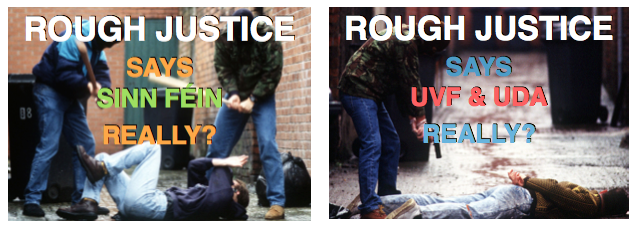
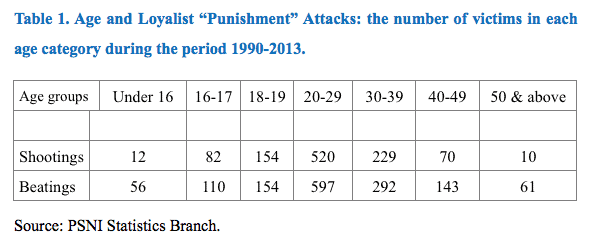
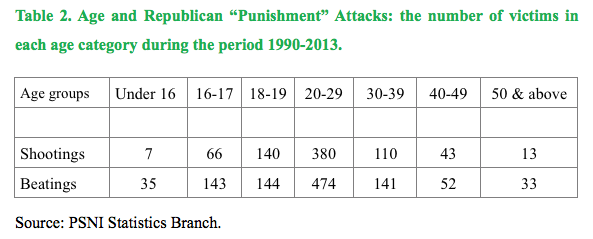
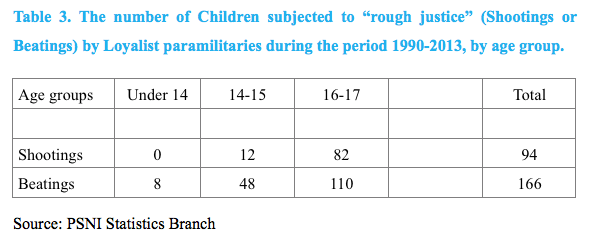
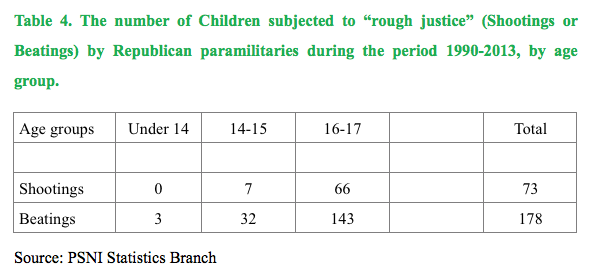
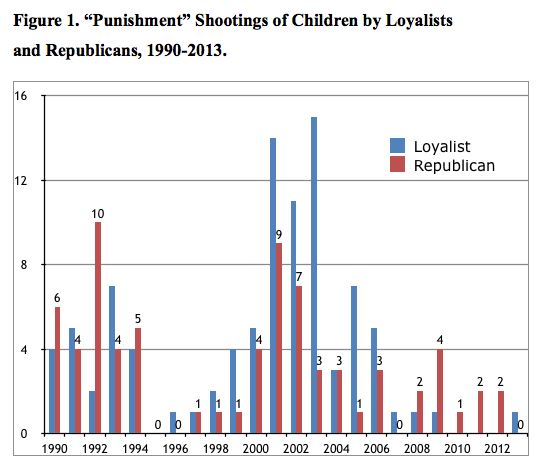
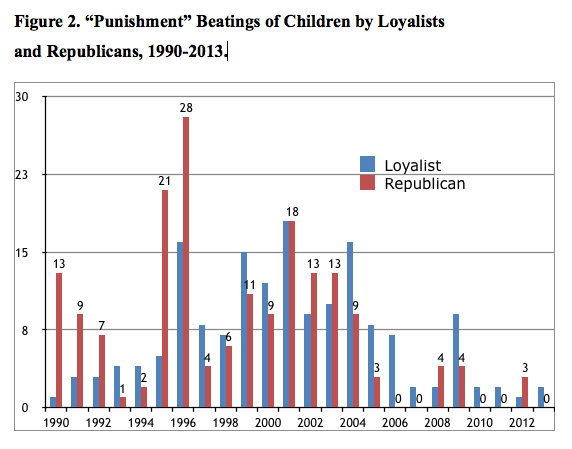
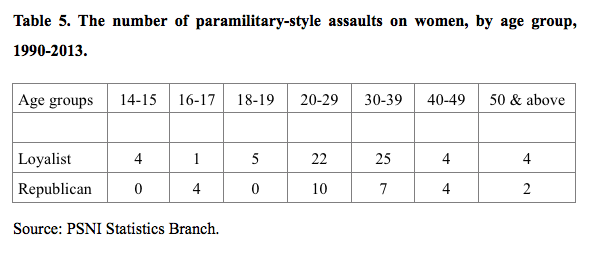
This is appalling. Could you recommend any texts for getting up to speed on the political history in Ireland? I only understand it in the vaguest of terms.
I would suggest either of the following as a start:
Modern Ireland: 1600-1972 by RF Foster 1990
http://www.amazon.com/Modern-Ireland-1600-1972-R-Foster/dp/0140132503
The Transformation Of Ireland 1900-2000 by Diarmaid Ferriter, 2010
http://www.amazon.com/Transformation-Ireland-1900-2000-Diarmaid-Ferriter-ebook/dp/B0037Z8SLS/ref=la_B001H6ODPY_1_2?s=books&ie=UTF8&qid=1415935503&sr=1-2
Bah. No kiindle version. Going to have to suck it up and read like a pilgrim. Ah well :p
And thanks for the links.